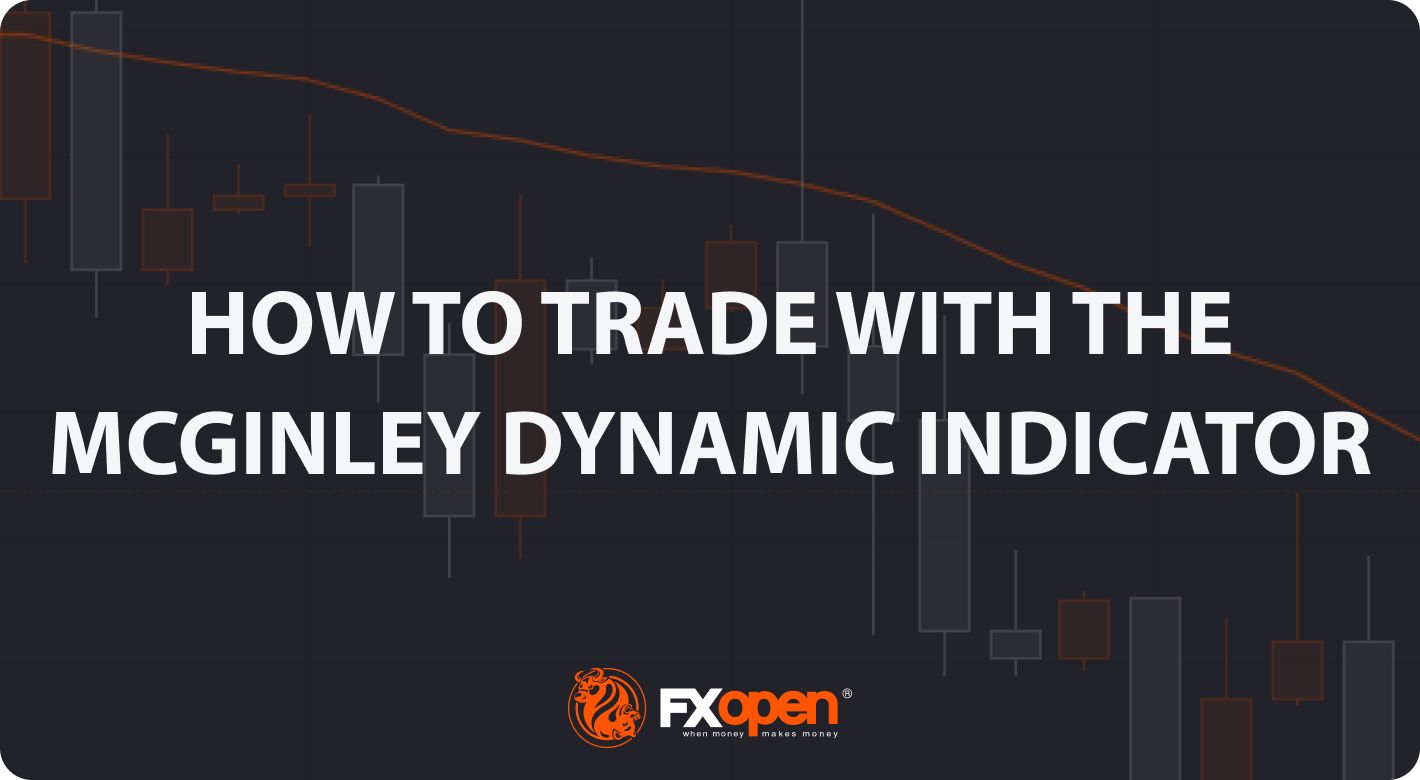FXOpen

The McGinley Dynamic indicator is an understated tool that many are unaware of, offering an innovative approach to minimising lag in moving averages and reacting to fast-moving financial markets. In this article, we will explore how this indicator works, how to set it up, and what signals it produces.
Understanding the McGinley Indicator
Introduced by John R. McGinley in 1990, the McGinley Dynamic indicator is a unique tool designed to solve a common problem in the world of trading - the “lag” associated with moving averages. The most popular moving averages, like the simple moving average (SMA), exponential moving average (EMA), and weighted moving average (WMA), aren’t able to adapt to fast-moving markets, meaning they lag behind the latest price movements and often produce false signals.
The McGinley Dynamic is a type of moving average that can adjust itself according to the speed of the markets. When speed picks up (represented by increased volatility), it closely follows price action without significant separation between price and its line. The indicator slows down in calmer markets and generally avoids the whipsaws commonly seen in other moving averages.
At its core, the McGinley Dynamic indicator is just another way to smooth out price action and gauge the potential direction of the market. But its ability to adapt and adjust itself sets it apart from other moving averages and allows traders to gain a much more accurate understanding of market dynamics. This is why many in the know call it “the most reliable indicator you have never heard of.”
McGinley Dynamic Formula and Calculation
The calculation of the McGinley Dynamic Indicator may seem a bit complex at first glance, but it’s based on a simple principle: adapting quickly to changes in the market.
It’s calculated using the following formula:
MD = MD1 + (Price - MD1) / (N * (Price/MD1)^4)
In this formula:
- MD is the McGinley Dynamic value that we're aiming to calculate.
- MD1 is the previous period's McGinley Dynamic value.
- Price is the current period's price.
- N is a constant factor, usually set to a value similar to that of a moving average period (for instance, 10, 14, or 20).
In simple terms, this formula calculates the difference between the current price and the previous McGinley Dynamic value. It then divides this difference by a value that changes depending on the ratio of the current price to the previous McGinley Dynamic value. This result is then added to the last value to arrive at the current value.
The crucial part of this formula is the (Price/MD1)^4 component. This factor is what allows the McGinley Dynamic Indicator to adjust itself to the speed of the market. When the price moves quickly, this factor increases, causing the indicator to react more rapidly. The opposite is true for slow-moving price action.
McGinley Dynamic Indicator: Settings
Now that we have briefly examined what the McGinley Dynamic is and how it’s calculated let’s look at how to set it up. If you’re wondering, “Where can I find the McGinley Dynamic indicator?” it should be available on most trading platforms under “Indicators.” In FXOpen’s native TickTrader platform, you’ll find it by clicking “Indicators.” Just select McGinley Dynamic to add it to your chart.
The McGinley Dynamic has a single input: its length. It’s set to 14 by default, but you’re welcome to customise it to suit your preferences. Objectively, it’s tricky to determine the McGinley Dynamic Indicator’s best settings. A longer period will smooth out its line but will be less responsive. Meanwhile, a shorter period will make the indicator more sensitive but may also produce more false signals.
While we have included a chart above to demonstrate the difference between the default 14-period (blue) and 7-period (orange) lines, it’s worth experimenting to find the best settings for your style. For instance, you might prefer a shorter period if you take a shorter-term view of the market and vice versa.
How to Use the McGinley Dynamic Indicator in Trading
As with other moving averages, it’s best to include the McGinley Dynamic indicator in a more comprehensive strategy rather than solely relying on it for trading signals. Even McGinley himself stated that his indicator is simply a smoothing mechanism instead of a tool that generates concrete, tradeable signals. However, there are still some valuable insights that it can offer.
Identifying Market Trends
The McGinley Dynamic is primarily a trend-following indicator. When it rises, the trend is likely bullish. When the indicator falls, it suggests a downtrend. This is further confirmed when the price sits above or below the line; in other words, the current trend is strong when the price exceeds its moving average.
These signals can help qualify a trade. For example, a trader may look for the indicator to slope upward and for the price to trade above it before considering a buy position. Then, they could use other technical factors to confirm their bias and find a suitable entry point.
McGinley Dynamic Crossover
When using the SMA or EMA, many traders look for a faster moving average to cross over its slower counterpart to anticipate the market's future direction. Traders can use the McGinley Dynamic in the same way. An added bonus of the indicator is that its improved accuracy generally reduces the frequency of false crossover signals.
When the shorter-period line crosses above a longer-period line, it can be interpreted as bullish, while the opposite can hint at a potential downtrend. Likewise, this can act as a signal for traders to start considering a position.
Confirming Support or Resistance
Apart from identifying market trends and crossovers, the McGinley Dynamic indicator can also act as a dynamic support and resistance level. While it’s generally too unreliable to take trades based on this alone, it can provide confluence to other types of support and resistance, like horizontal levels or trendlines. This can give traders extra confidence in their bias and help them identify potential entry/exit points.
How Does McGinley Dynamic Compare to Other Indicators?
Overall, it’s easy to see that the McGinley Dynamic indicator takes regular moving averages to the next level. But how does it compare to some of the better-known indicators?
McGinley Dynamic vs Moving Averages
Moving averages, like the SMA, EMA, and WMA, are some of the most widely-used indicators. To briefly explain each:
- SMA: An equally-weighted moving average that calculates the average price over a given period.
- EMA: The EMA is similar to the SMA, but it applies more weight to recent data and exponentially decreases the weight of older data, making it more reactive.
- WMA: The WMA is closely related to the EMA, assigning more weight to recent price action. The main difference is that each weight is explicitly defined and decreases linearly, not exponentially.
The main disadvantage of these indicators is that they lag, especially the SMA. Even EMA and WMA suffer from lag. That’s not to say the McGinley dynamic doesn’t lag. But, its adaptation to volatility boosts its responsiveness and provides a more accurate reflection of the market, giving it an edge over these indicators.
McGinley Dynamic vs MACD
The moving average convergence divergence (MACD) is a momentum indicator that measures the relationship between two MAs, typically plotted as a histogram. It allows traders to gauge a trend’s strength and spot impending reversals. While MACD produces more tradeable signals, it still suffers from lag. Using the McGinley Dynamic indicator with MACD can be an effective strategy since McGinley crossovers can be used to confirm the latter’s reversal signals.
McGinley Dynamic vs RSI
The relative strength index (RSI), a momentum oscillator, helps us identify potential market reversals by indicating overbought and oversold conditions. Unlike the MACD, RSI has no association with moving averages but can still be used to measure trend strength. When its value is above 50, the trend is said to be bullish; when it’s below 50, the trend is supposed to be bearish. Combined with the previously mentioned McGinley Dynamic signals, using the two together can offer traders an effective way to confirm their trend bias.
Final Thoughts
In summary, the McGinley Dynamic indicator is a lesser-known but effective moving average. Its unique mechanism for reducing lag and quickly reacting to volatile price action distinguishes it from other moving averages, offering traders a more accurate gauge of market conditions. Ready to try this indicator for yourself? You can open an FXOpen account to get started with the McGinley Dynamic in 600+ markets and benefit from the advanced TickTrader platform, competitive pricing, and ultra-fast execution. Good luck!
This article represents the opinion of the Companies operating under the FXOpen brand only. It is not to be construed as an offer, solicitation, or recommendation with respect to products and services provided by the Companies operating under the FXOpen brand, nor is it to be considered financial advice.
Stay ahead of the market!
Subscribe now to our mailing list and receive the latest market news and insights delivered directly to your inbox.








